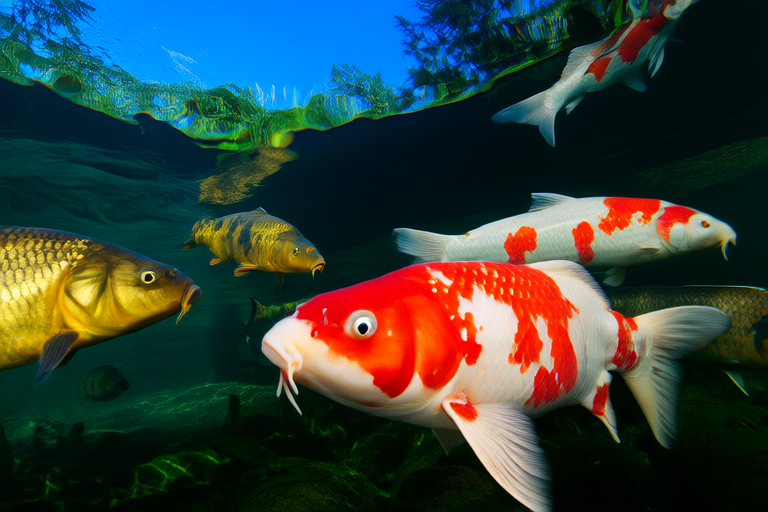The Ultimate Guide to Feeding and Caring for Your Koi
Koi fish, known for their vibrant colors and graceful movements, have become increasingly popular among aquarium enthusiasts and pond owners alike. These freshwater fish, originating from Japan, are descendants of common carp and are valued for their aesthetic appeal and relatively easy care. With proper feeding and maintenance, koi can live up to 30 years or more, making them a long-term addition to any water garden.
Importance of Proper Feeding Techniques
Proper feeding is crucial for the health and longevity of your koi. Understanding what and how much to feed them at different times of the year and during various stages of their life is essential. Koi require a balanced diet that includes protein, fats, carbohydrates, vitamins, and minerals.
During spring and summer, when water temperatures are above 60°F (15°C), koi are most active and have higher metabolic rates. At this time, they benefit from a high-protein diet. Foods rich in protein, such as pellets or flakes, should be provided several times a day. In contrast, during fall and winter, when water temperatures drop below 60°F (15°C), their metabolism slows down, and they need less food. Feeding should be reduced to once a day or even stopped entirely if the water temperature falls below 40°F (4°C).
The type of food also varies depending on the koi’s life stage. Young koi, called frys or fingerlings, require specialized food with higher protein content to support their rapid growth. As they mature, their dietary needs change, and they can transition to adult koi food.
Determining the Correct Amount of Food
The quantity of food you provide should be based on water temperature and activity levels. Generally, koi should eat only as much food as they can consume within five minutes. Overfeeding can lead to poor water quality and health issues for the fish.
Water temperature plays a critical role in determining how much to feed. When the water temperature is between 60°F and 75°F (15°C to 24°C), koi can eat up to 3% of their body weight per day. Between 75°F and 85°F (24°C to 29°C), reduce the amount to about 1% of their body weight. Above 85°F (29°C), feeding should be minimized to avoid stressing the fish.
Maintaining Optimal Water Quality
Optimal water quality is vital for koi health. Regular testing of pH, ammonia, nitrite, and nitrate levels ensures a healthy environment. A pH level between 7.2 and 8.0 is ideal for koi. Ammonia and nitrite levels should be kept at zero, while nitrate levels should be below 50 ppm. Maintaining these parameters helps prevent stress and disease in your koi.
Adequate filtration and aeration systems are necessary to maintain clean and oxygen-rich water. Regular cleaning of filters and skimmers prevents clogs and maintains efficient water circulation. Additionally, performing partial water changes, typically 10-20% weekly, helps dilute harmful substances and replenish essential minerals.
Common Health Issues and Preventive Measures
Like any pet, koi can suffer from various health issues. Common problems include fin rot, ich (white spot disease), and parasites. Fin rot, characterized by frayed or disintegrating fins, often results from poor water quality or physical damage. Ich, a parasitic infection, causes small white spots on the fish’s skin and gills. Parasites can enter the pond through contaminated plants or other fish.
To prevent these issues, ensure a clean and well-maintained pond with good water quality. Quarantine new fish before introducing them to the main pond to avoid spreading diseases. Regularly inspect your koi for signs of illness, and treat promptly if symptoms appear. Consult a veterinarian specializing in aquatic animals for diagnosis and treatment.
When to Seek Professional Help
If you notice significant changes in your koi’s behavior, appearance, or appetite, it may be time to consult a professional. Signs of distress include lethargy, erratic swimming, loss of color, or unusual lesions. Early intervention can make a significant difference in treating and managing health issues effectively.
Creating an Enriching Environment
Providing an enriching environment is crucial for the well-being of your koi. A spacious pond with plenty of hiding spots, such as rocks and plants, offers a stimulating habitat. Koi enjoy exploring and interacting with their surroundings, which promotes mental and physical stimulation.
Regular maintenance and observation are key to ensuring a thriving pond ecosystem. Clean the pond regularly, monitor water parameters, and keep a close eye on your koi’s behavior. By doing so, you can identify potential issues early and address them promptly.
In conclusion, caring for koi requires attention to detail and commitment. By understanding their dietary needs, maintaining optimal water quality, and providing an enriching environment, you can ensure the health and happiness of your koi. Whether you’re a novice or experienced owner, following these guidelines will help you create a thriving pond ecosystem where your koi can flourish.
